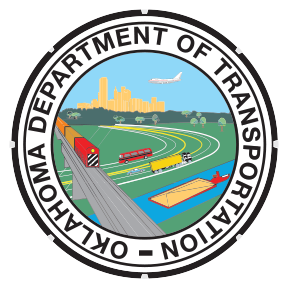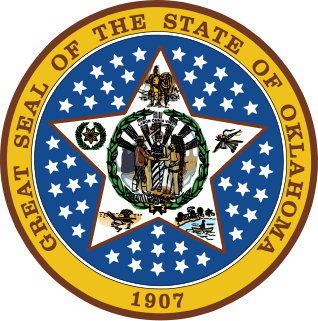
The Oklahoma Department of Transportation (ODOT) is an agency of the government of Oklahoma responsible for the construction and maintenance of the state's transportation infrastructure. Under the leadership of the Oklahoma Secretary of Transportation and ODOT Executive Director, the Department maintains public infrastructure that includes highways and state-owned railroads. Along with the Oklahoma Turnpike Authority, the Department is the primary infrastructure construction and maintenance agency of the State.
The United States federal budget for fiscal year 2009 began as a spending request submitted by President George W. Bush to the 110th Congress. The final resolution written and submitted by the 110th Congress to be forwarded to the President was approved by the House on June 5, 2008.

The Oklahoma State Board of Equalization is an agency of the state of Oklahoma that is responsible for tax administration. The Board is responsible for adjusting and equalizing the valuation of real and personal property of the several counties of Oklahoma. Board is also responsible for providing an estimate of all revenue that will be available for appropriation by the Oklahoma Legislature for the coming fiscal year.

The Oklahoma State Budget for Fiscal Year 2011, is a spending request by Governor Brad Henry to fund government operations for July 1, 2010–June 30, 2011. Governor Henry and legislative leader approved the budget in May 2010. This was Governor Henry's eight and final budget submitted as governor.
The Oklahoma State Budget for Fiscal Year 2004 was the spending request by Governor Brad Henry to fund government operations for July 1, 2003–June 30, 2004. Governor Henry and legislative leaders approved the budget in May 2003. This was Henry's first budget submitted as governor.
The Oklahoma State Budget for Fiscal Year 2005, was a spending request by Governor Brad Henry to fund government operations for July 1, 2004–June 30, 2005. Governor Henry and legislative leader approved the budget in May 2004.
The Oklahoma State Budget for Fiscal Year 2006, was a spending request by Governor Brad Henry to fund government operations for July 1, 2005–June 30, 2006. Governor Henry and legislative leader approved the budget in May 2005.
The Oklahoma State Budget for Fiscal Year 2007, was a spending request by Governor Brad Henry to fund government operations for July 1, 2006–June 30, 2007. Governor Henry and legislative leader approved the budget in May 2006.
The Oklahoma State Budget for Fiscal Year 2008, was a spending request by Governor Brad Henry to fund government operations for July 1, 2007–June 30, 2008. Governor Henry and legislative leader approved the budget in May 2007.

The Oklahoma State Budget for Fiscal Year 2012, is a spending request by Governor Mary Fallin to fund government operations for July 1, 2011–June 30, 2012. Governor Fallin proposed the budget on February 7, 2011. This was Governor Fallin's first budget submitted as governor.
The Oklahoma State Budget for Fiscal Year 2010, is a spending request by Governor Brad Henry to fund government operations for July 1, 2009–June 30, 2010. Governor Henry and legislative leader approved the budget in May 2009.

The Oklahoma State Budget for Fiscal Year 2013, is a spending request by Governor Mary Fallin to fund government operations for July 1, 2012–June 30, 2013. Governor Fallin proposed the budget on February 6, 2012. This was Governor Fallin's second budget submitted as governor.
The Oklahoma State Budget for Fiscal Year 2009, was a spending request by Governor Brad Henry to fund government operations for July 1, 2008–June 30, 2009. Governor Henry and the Legislature approved the budget in May 2008.

The Fifty-fourth Oklahoma Legislature was the meeting of the legislative branch of the government of Oklahoma from January 8, 2013 to January 5, 2015. The first session met from February 4, 2013, to May 24, 2013, in the Oklahoma State Capitol in Oklahoma City, during the third year of the first administration of Governor Mary Fallin. After the 2012 elections, the Republican Party held more than two-thirds of the seats in the Oklahoma Senate and the Oklahoma House of Representatives.

The Oklahoma State Budget for Fiscal Year 2014, is a spending request by Governor Mary Fallin to fund government operations for July 1, 2013–June 30, 2014. Governor Fallin proposed the budget on February 4, 2013. This was Governor Fallin's third budget submitted as governor.

The Fifty-sixth Oklahoma Legislature is the current meeting of the meeting of the legislative branch of the government of Oklahoma, composed of the Senate and the House of Representatives. It meets in Oklahoma City, Oklahoma from January 3, 2017, to January 3, 2019, during the final two years of the second administration of Governor Mary Fallin. The November 2016 elections maintained Republican control of both the House and Senate.









